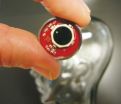New study finds that 75 percent of patients taking popular blood-thinners are getting wrong dose
Millions at risk for serious problems like uncontrolled bleeding or developing blood clots
2012-11-06
(Press-News.org) SALT LAKE CITY – Cardiology researchers at the Intermountain Medical Center Heart Institute have found that approximately 75 percent of patients taking two common blood-thinning drugs may be receiving the wrong dosage levels, according to a new study.
This could put them at risk for serious problems like uncontrolled bleeding or developing blood clots.
Millions of Americans with coronary artery disease take one of the two drugs — clopidogrel (Plavix) and prasugrel (Effient) — to prevent harmful blood clots that can cause a stroke or heart attack. Current guidelines recommend that all patients take the same standardized dose. But in this new study of 521 patients, researchers at the Intermountain Medical Center Heart Institute found that dose is not effective for all patients.
"There's a sweet spot, an appropriate range for each patient. But we found that not many people are falling into that range," said cardiologist Brent Muhlestein, MD, a cardiac researcher at the Intermountain Medical Center Heart Institute.
Dr. Muhlestein is presenting the group's findings on Nov. 6 at the American Heart Association Scientific Sessions 2012 in Los Angeles.
"We showed that by performing a simple blood test to see whether or not the blood is clotting properly, we can determine whether patients are getting an appropriate, individualized dose of the medications," he says. "The test is easy to perform, but not widely used."
The Intermountain Medical Center Heart Institute study could help lead to personalized treatment and improved results for millions of people taking the drugs. It may also help cut pharmacy bills for many patients. The annual cost for one of the medications is more than $1,800. Finding the lowest effective dose for those patients could conceivably cut their bill in half.
Major findings of the study show that:
Half of patients taking clopidogrel were getting too little of the drug to prevent clotting most effectively. A quarter were getting too much. Only a quarter were getting an accurate dose.
Half of patients taking prasugrel are getting too much of the drug, which could lead to dangerous bleeding. A quarter were getting too little. Only a quarter are getting the appropriate dose.
The researchers also discovered that common indicators like age, gender, cholesterol levels, and history of heart problems were not good predictors for how a person would react to the drugs.
"That means there's not an easy way to predict how a person will react to these drugs. But the blood test is very effective," said Dr. Muhlestein. "In fact, a physician could have the test machine on his or her desk and perform the test right there in the office."
###
The Intermountain Medical Center Heart Institute is one of the premier cardiac centers in the country. Intermountain Medical Center is the flagship facility for the Intermountain Healthcare system.
Other members of the research team included: Tami L. Bair; Benjamin D. Horne; Sterling T. Bennett; Brian K. Whisenant; Jeffrey L. Anderson and Donald L. Lappe.
END
ELSE PRESS RELEASES FROM THIS DATE:
2012-11-06
Researchers from Aarhus University, Denmark, have now discovered an important mechanism behind one of our most fundamental lines of immune function. The discovery has been published in the esteemed scientific journal, The Journal of Immunology, where it has been highlighted as a top story.
In collaboration with colleagues from USA and Turkey, they have discovered exactly which enzymes collaborate in the first line of the immune defence. Thus, they answer a central question about the so-called complement system, which has been a focal point of the scientific field for the ...
2012-11-06
VIDEO:
Figaro, a Goffin's Cockatoo, makes and uses a tool.
Click here for more information.
Goffin's cockatoos are a highly playful and curious Indonesian cockatoo species. Therefore, cognitive biologists are now using them as a model species to investigate intelligent behaviour in birds. Together with researchers from the University of Oxford, Alice Auersperg and Birgit Szabo from the Department of Cognitive Biology at the University of Vienna have made a sensational discovery: ...
2012-11-06
With its deeply embedded roots, sturdy trunk and dense profusion of branches, the Tree of Life is a structure of nearly unfathomable complexity and beauty. While major strides have been made to establish the evolutionary hierarchy encompassing every living species, the project is still in its infancy.
At Arizona State University's Biodesign Institute, Sudhir Kumar has been filling in the Tree of Life by developing sophisticated methods and bioinformatics tools. His latest research, which appeared on the advance online edition of the Proceedings of the National Academy ...
2012-11-06
Amyotrophic lateral sclerosis (ALS) is a neurodegenerative disease with an occurrence rate in France similar to multiple sclerosis (two to three new cases per year for every 100,000 residents). It has a specific affect on neurons responsible for motor control, in particular motor neurones and central motor neurones. The former, located in the spinal cord, are directly linked to muscles and are used for muscle contraction and stretching. The latter, located in the brain, receive movement orders. As the disease develops, the neurons degenerate and the muscles are no longer ...
2012-11-06
To this day it remains a mystery why the cerebral pressure in certain people suddenly increases. The consequences, however, are better understood: The blood circulation is disrupted and after a while parts of the brain may die off, similar to what occurs in a stroke. This is how dementia takes its insidious path. Experts estimate that up to ten percent of all cases of dementia in Europe can be attributed to rising blood pressure in the brain. Still, making the diagnosis is tough. People with a heightened susceptibility to a rise in intracranial pressure must be treated ...
2012-11-06
Each year throughout the world, up to 22 million tons of rubber are processed and a large portion of it goes into the production of vehicle tires. Once the products reach the end of their useful life, they typically land in the incinerator. In the best case, the waste rubber is recycled into secondary products. Ground to powder, the rubber residues can be found, for example, in the floor coverings used at sports arenas and playgrounds, and in doormats. But until now, the appropriate techniques for producing high-quality materials from these recyclables did not exist. Researchers ...
2012-11-06
Extended work shifts of twelve hours or longer are common and popular among hospital staff nurses, but a new study reports that nurses working longer shifts were more likely to experience burnout, job dissatisfaction, and patients were more dissatisfied with their care.
In the first study to examine the relationship between nurse shift length and patients' assessment of care, researchers from the University of Pennsylvania School of Nursing report that nurses working shifts of ten hours or longer were up to two and a half times more likely than nurses working shorter ...
2012-11-06
(Philadelphia, PA) – Scientists for the first time have evidence showing how a widely used type of "targeted" cancer drug can be dangerous to the heart.
Studying mice with the equivalent of a heart attack, researchers found that the drug sorafenib (Nexavar) – which inhibits proteins called tyrosine kinase receptors (RTKs), and is used in kidney and liver cancer treatment – can interfere with heart stem cell activity, affecting the heart's ability to repair itself after injury. The findings suggest that sorafenib and other similar drugs that target these kinds of protein ...
2012-11-06
(Philadelphia, PA) – When a person has a heart attack, portions of the heart muscle die in the next several days or even weeks if deprived of oxygen for long enough. The recovering heart slowly remodels itself, even fostering the growth of new blood vessels, in an attempt to regain some of its former function. But all too often, the remodeling is actually harmful, and the damaged heart is on an inevitable downward slide to heart failure.
Now, scientists at the Center for Translational Medicine at Temple University School of Medicine have identified a key target they hope ...
2012-11-06
DUBLIN, November 6, 2012 – Taiho Pharmaceutical Co., Ltd. (HQ: Tokyo, President: Masayuki Kobayashi), the developer of the first orally available fluorouracil (FU) Chemotherapeutic treatment (TS-1/S-1), is presenting early stage data for eight novel oncology compounds, including potential first-in-class therapies. The data being presented during the 24th EORTC-NCI-AACR Symposium on Molecular Targets and Cancer Therapeutics from November 6 – 9, 2012 in Dublin, Ireland underscore Taiho's steadfast commitment to improving cornerstone anti-metabolic cancer agents and developing ...
LAST 30 PRESS RELEASES:
[Press-News.org] New study finds that 75 percent of patients taking popular blood-thinners are getting wrong dose
Millions at risk for serious problems like uncontrolled bleeding or developing blood clots



